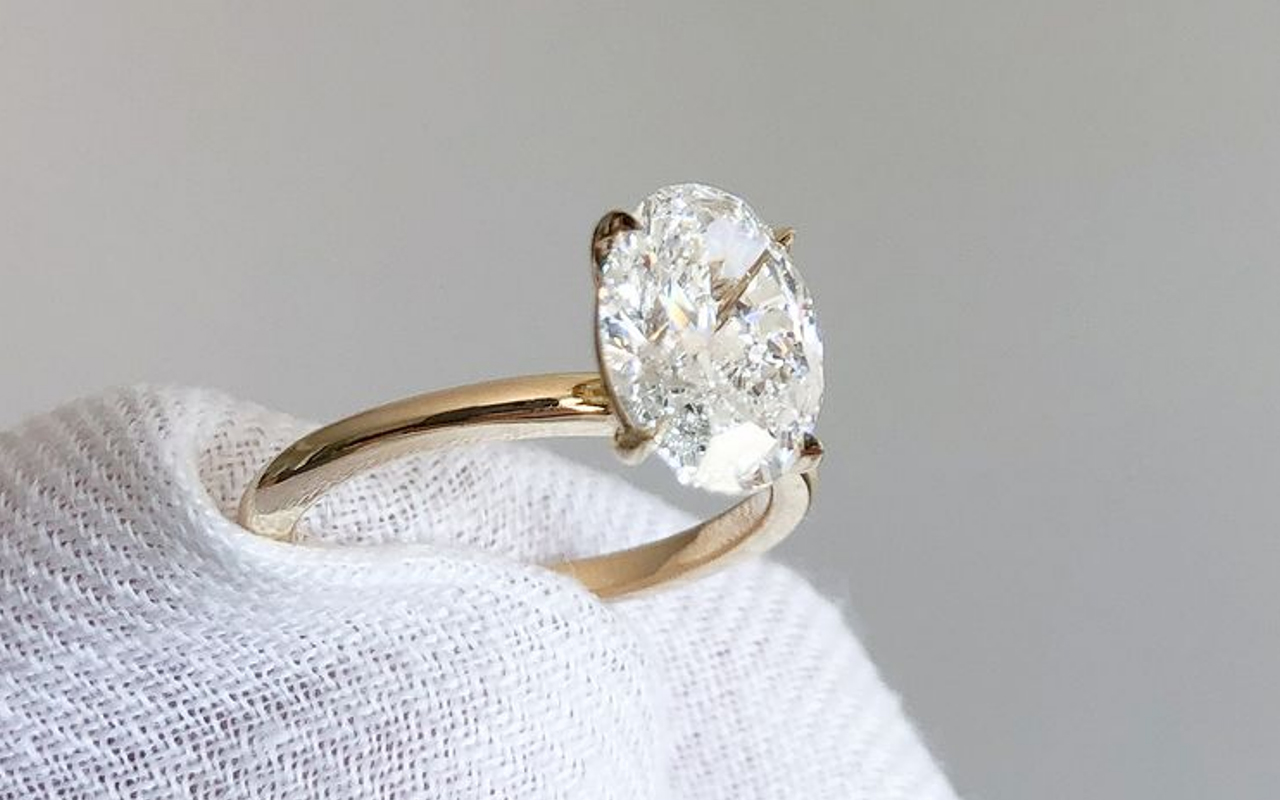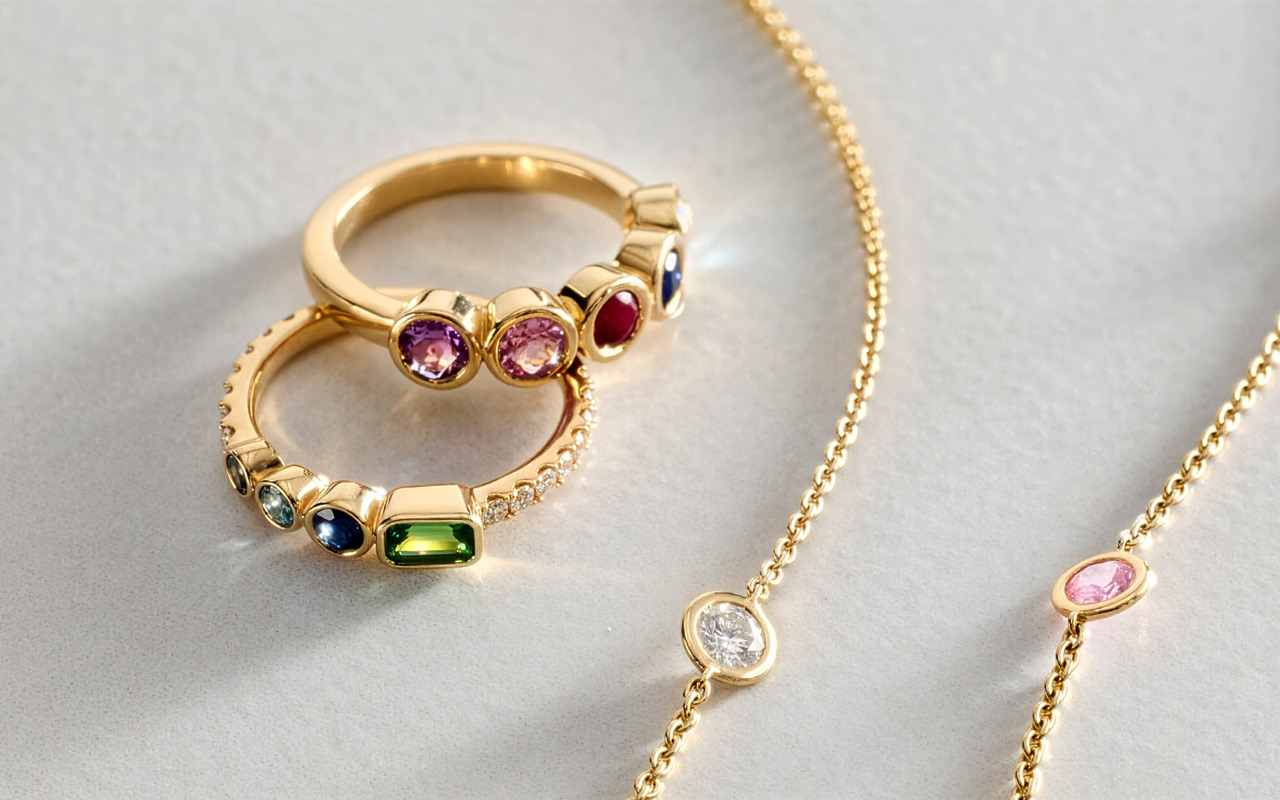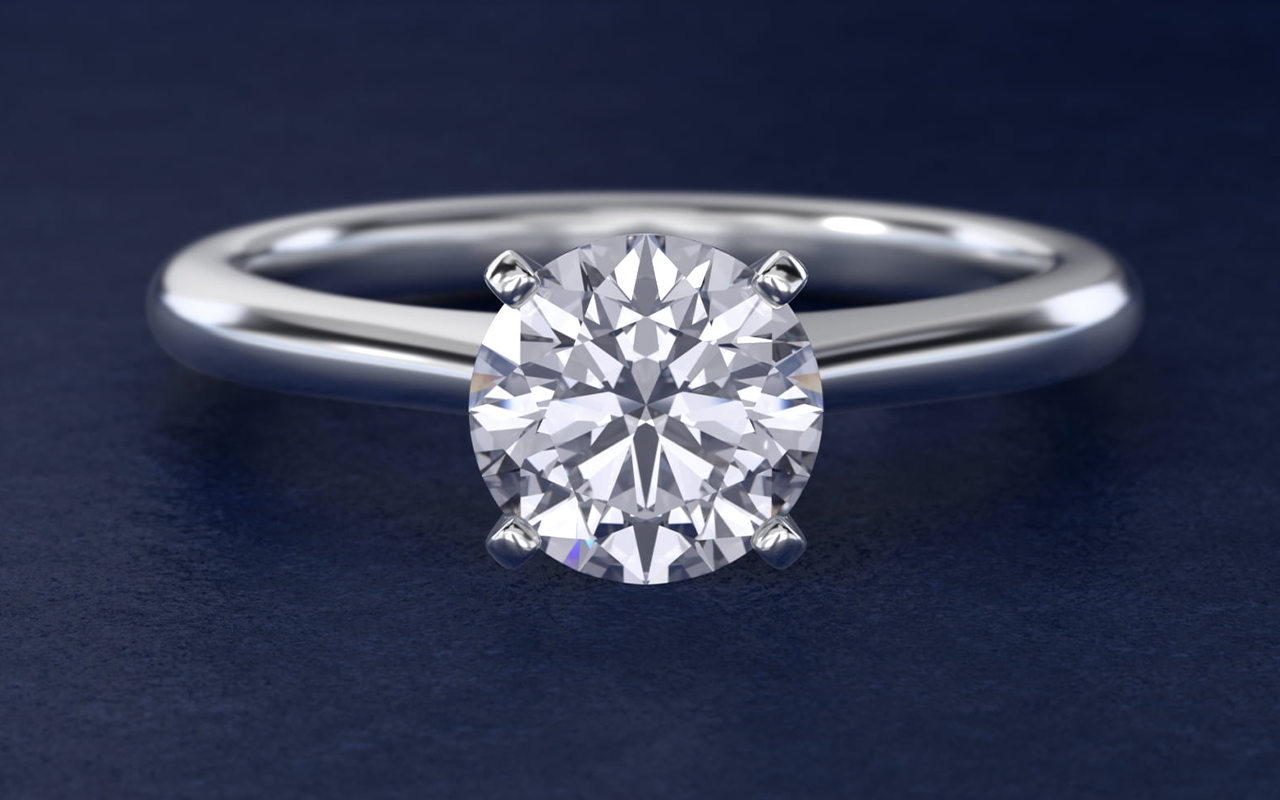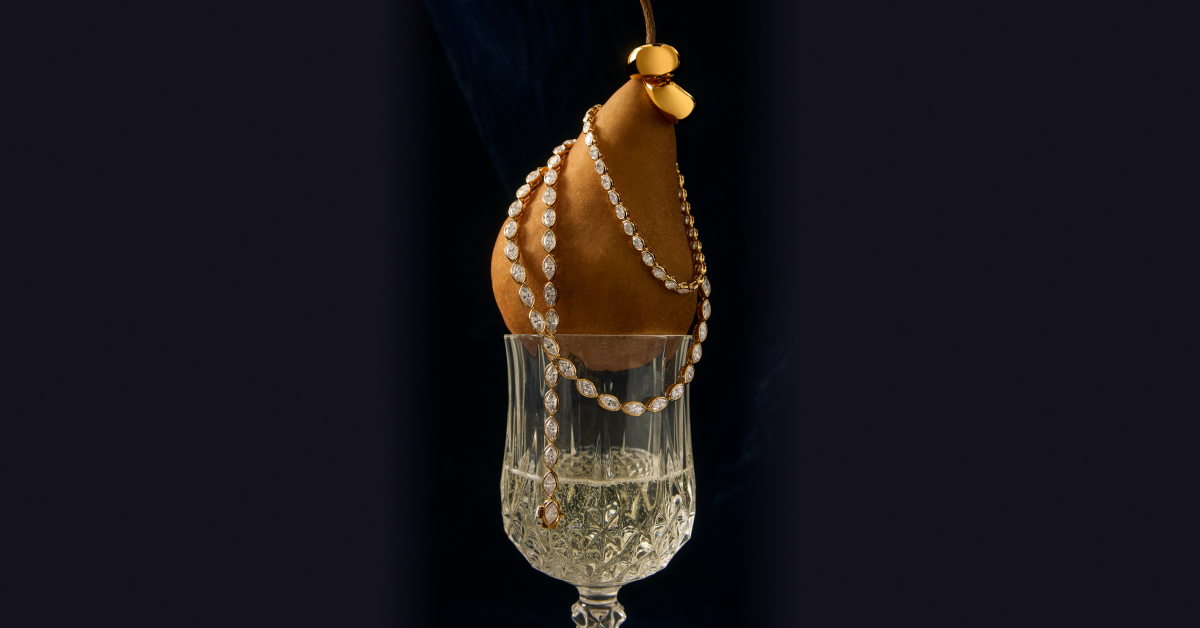F color diamonds, the third-highest grade, are exquisite near-colorless stones that offer outstanding brilliance without the higher cost of top-tier D or E grades.
Understanding diamond color is essential for selecting the perfect stone that balances beauty and value. Among the various grades, an F color diamond is what many buyers choose due to its near-colorless appearance.
This article explores a color F diamond’s characteristics, how it compares to other grades and whether it’s the right choice for you. If you’re looking to buy budget-friendly diamonds, this diamond could be the ideal pick. Let’s explore what makes it a popular choice for elegant jewelry.
What Is an F Color Diamond?
An F color diamond is part of the colorless tier (D-F) on the diamond color scale. To the unaided eye, an F diamond looks bright and white, even when placed side by side with higher-grade D or E stones. It exhibits a very faint trace of color that’s only detectable under professional magnification.
Although it falls at the lower end of the “colorless” range, these diamonds deliver both impressive brilliance and great value for your budget.
They’re an excellent choice for those seeking a high-quality, radiant look without the premium price tag of D or E grades.
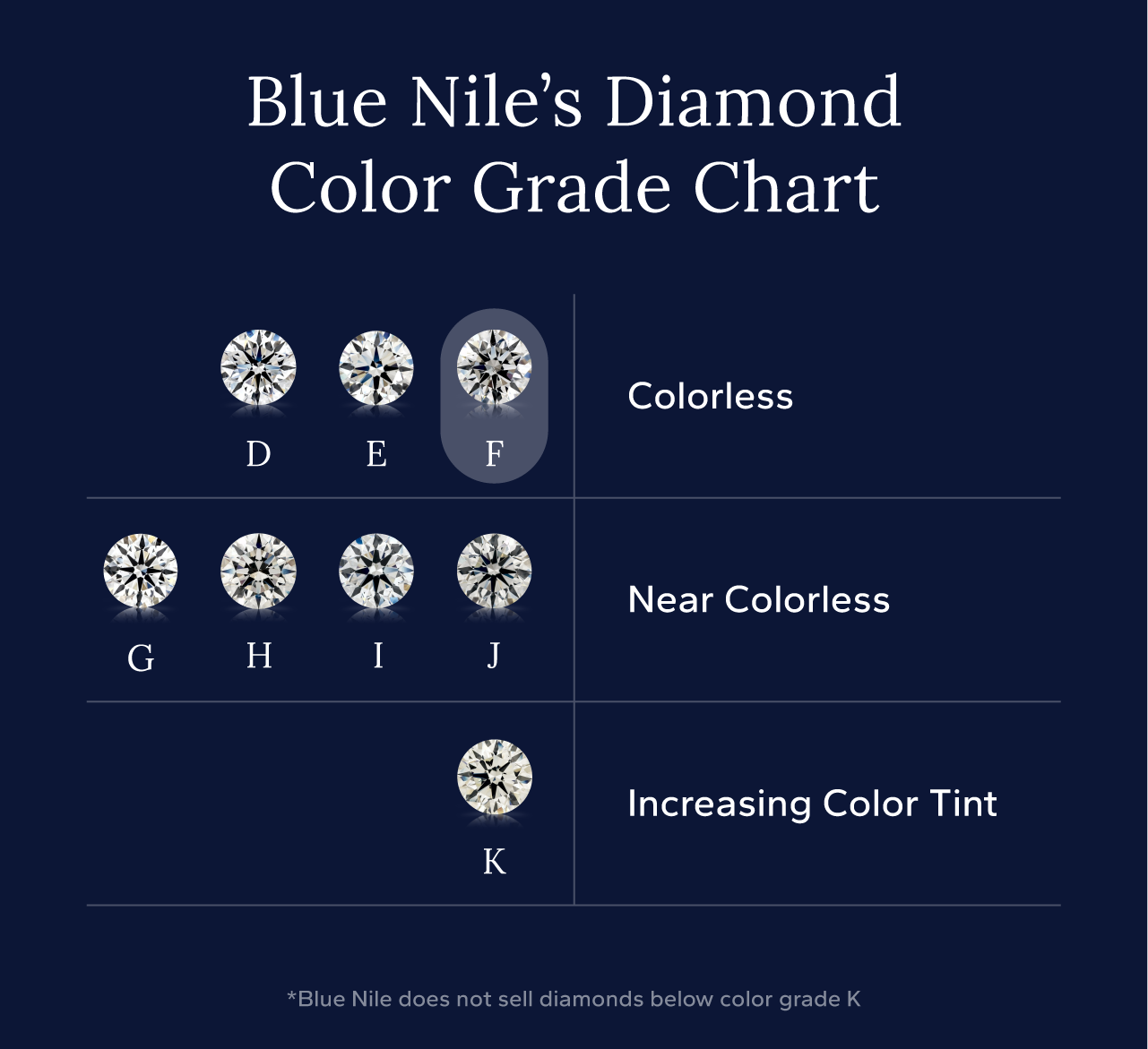
Color and the 4Cs
Among the 4Cs—cut, color, clarity and carat—color significantly influences a diamond’s visual appeal and price point. It’s graded on a letter scale from D to Z, with D being completely colorless and Z having a noticeable yellow or brown tint.
In the grading process, certified gemologists compare the diamond to masterstones under controlled lighting conditions. The goal is to determine how much, if any, color is visible. Here is the final grading you can find in most diamond color charts:
- D to F: These are the “colorless” grades, offering the purest, most transparent look. Diamonds in this range are extremely rare and highly prized, especially in smaller sizes or high-end jewelry.
- G to J: These are “near-colorless” diamonds with subtle hints of warmth. They often appear just as white as D-F in most settings and lighting conditions.
K to Z: These diamonds show increasing color tint, which can be more apparent in larger stones or in certain lighting.
How Does F Color Compare to Other Grades?
F color diamonds are colorless and typically exhibit only a faint, nearly imperceptible tint under professional examination.
To the unaided eye, especially in well-cut stones, an F diamond appears just as bright and white as a D or E. Because of this, many buyers opt for F grades at lower prices without compromising the stunning, icy-white appearance that makes diamonds so desirable.
Here’s a breakdown of how F diamonds compare to other grades on the diamond color chart.
Color Grades
Appearance Difference
Price Difference
F vs. D
F vs. E
F vs. G
F vs. Lower Grades
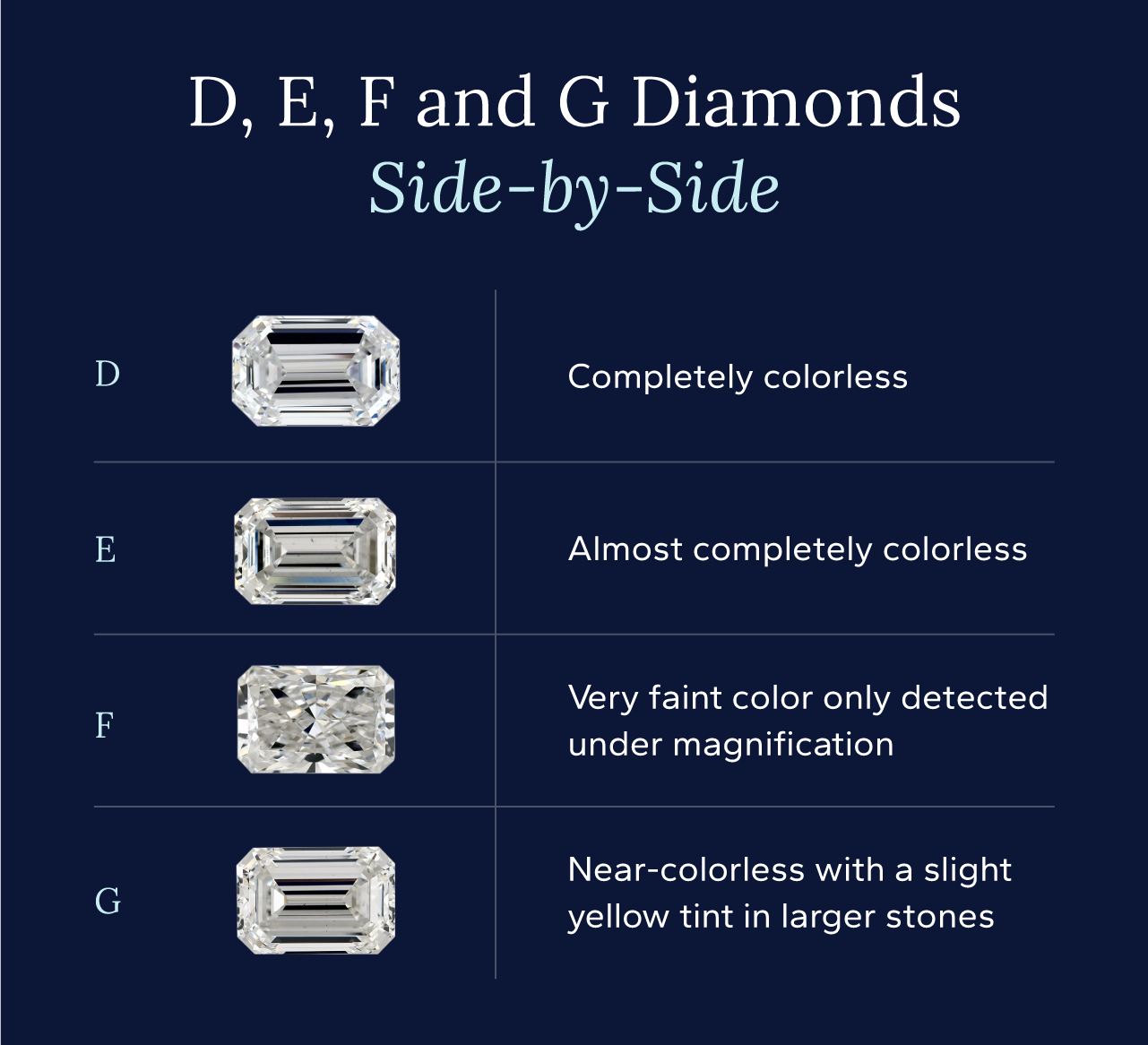
Is an F Color Diamond a Good Choice?
Choosing a diamond involves balancing beauty, quality and budget. A color F diamond offers a compelling combination of all three. Let’s see how this diamond shines in various jewelry styles and settings.
Engagement and Wedding Rings
If you don’t know how to choose an engagement ring but want a radiant, colorless look, an F color diamond is a good choice. It appears bright and icy in white gold, platinum or silver settings. This diamond allows you to maximize your budget without compromising the classic white aesthetic that traditionally symbolizes enduring love.
Everyday Jewelry
While F color diamonds are highly desirable, they may not be the best value-for-money choice for most everyday jewelry. Because they are still considered high-end, they tend to be only slightly less expensive than D and E grades.
For pieces like earrings or pendants that are worn daily, you might consider slightly lower color grades such as G or H. These options still look nearly colorless but come at a more affordable price, allowing you to allocate more funds toward clarity or size.
With White Gold or Silver
An F color diamond is a good fit for white gold or silver settings because these metals accentuate the diamond’s crisp, luminous glow. The cool tones of white gold and silver complement the near-colorless quality of an F diamond, making it look exceptionally vibrant.
In such settings, the faint trace of color in an F diamond is virtually invisible, giving you a flawless look without the premium price of higher-grade options.
With Platinum
Since platinum is a particularly premium and reflective metal, pairing it with a color F diamond can be an excellent choice. The cool, silvery hue of platinum enhances the diamond’s icy brilliance, ensuring that the subtle tint in the F diamond remains virtually undetectable.
While this pairing is more expensive overall, it creates a luxurious, high-end look that emphasizes the diamond’s quality and maximizes its visual impact.
With Yellow Gold
While D or E diamonds are often reserved for white metals, an F color diamond can actually work beautifully in warm-toned metals like yellow gold. The slight hue of the F diamond won’t clash or detract from the overall look of the warmer metal, like the higher-grade stones do. Instead, it can create a harmonious, elegant glow that complements the metal’s tone.
How to Choose the Best F Color Diamond
Selecting the right diamond color F involves understanding how various factors influence its appearance and value. Here, we’ll explore key considerations to help you make an informed decision and find the perfect piece.
Natural vs. Lab-Grown
When choosing between natural and lab-grown color F diamonds, it’s important to weigh your priorities. Key considerations include:
- Color consistency: Lab-grown F diamonds typically exhibit more uniform color since they are created in controlled environments, reducing the chance of natural inclusions affecting tone.
- Cost considerations: Lab-grown F color diamonds are generally more affordable than natural ones, offering excellent colorless quality at a lower price point.
- Environmental impact: Many buyers opt for lab-grown diamonds due to their responsibly sourced and non-mined production processes, with similar optical properties to natural stones.
- Rarity and value: The natural diamond formation processes make more colorless varieties harder to find. F color natural diamonds are rare wonders. A natural F diamond showcases the beauty and uniqueness of these stones.
Both options are durable and beautiful, but lab-grown diamonds often provide greater value, especially for those seeking larger stones or multiple pieces. Natural F color diamonds represent promise and rarity. Ultimately, your decision should reflect your budget and personal preferences.
Note
Lab-created diamonds have the same optical, chemical and physical properties as natural diamonds. However, because lab-created diamonds can be produced in abundance, they are less expensive and make larger size diamonds more affordable. Their relative abundance may not ensure that they will hold value over time.
Setting Type
The metal choice and stone setting impact how the diamond’s color is perceived. Let’s see how F grade diamonds pair with different types of metals and settings:
- White Metals: White gold and platinum enhance the icy, bright appearance of F color diamonds, making them look exceptionally colorless.
- Yellow or Rose Gold: Slightly warmer metals can complement the faint hue of F diamonds, creating a chic, harmonious look.
- Halo and Pavé Settings: F diamonds in these settings will appear even more luminous and vibrant, as the smaller stones’ subtle hues are less noticeable.
- Solitaire Settings: Solitaire pieces showcase the diamond’s clarity and color in a simple, classic setting.
F color diamonds pair beautifully with white metals for a crisp, icy appearance, but can also complement warmer settings depending on your style. Selecting the right combination allows you to create a personalized look that showcases the diamond’s exquisite qualities.
Cut and Shape
The cut and shape influence how well an F grade diamond masks any subtle color tint. Well-cut diamonds, especially those with excellent proportions, maximize light reflection, making even slight traces of color less noticeable. Here are some of the ideal cuts for F diamonds:
- Round Brilliant: This shape excels at disguising slight color variations due to its light-reflecting facets.
- Princess, Cushion, and Radiant: These shapes benefit from their faceting patterns, which hide body color, making them ideal for F-grade stones.
- Emerald and Asscher: Step cuts reveal more of a diamond’s color, so higher grades, such as F, are recommended for these shapes to retain their brightness.
- Unique Shapes: Fancy shapes with larger tables or fewer facets, such as oval or pear, may show subtle tinting. Therefore, you should choose a well-cut F diamond for optimal radiance.
Choosing a shape and cut that optimizes light performance ensures your diamond looks vibrant and colorless. Prioritize well-cut diamonds in any shape for maximum glow.
Clarity
Clarity impacts how pure and bright your diamond appears, especially in an F color stone, where any imperfections can become more noticeable. Higher clarity grades, such as VS1 or above, ensure that inclusions are invisible to the eye. In lower clarity grades, inclusions may interfere with light reflection, diminishing the stone’s brilliance.
When selecting an F diamond, prioritizing clarity ensures that you achieve a stunning, eye-clean appearance that maximizes the diamond’s overall beauty and value.
Carat
Carat weight influences both the visual impact and price of your diamond. Buying just below a whole carat, such as 0.9ct instead of 1.0ct, can significantly reduce costs without a noticeable difference in size or radiance.
For larger stones, the slight body color of a lower grade becomes more apparent, making a higher color grade, such as F, advisable for stones over 1 carat. Conversely, for smaller diamonds, you might opt for a slightly lower color grade to stay within budget while still achieving a stunning look.
Carefully consider carat weight in conjunction with other factors like your overall budget to find the perfect diamond that looks mesmerizing in any setting.
Inclusions
Inclusions and imperfections can impact the diamond’s glow, especially in an F color stone where clarity plays a key role.
Opting for a higher clarity grade, such as VS1 or VS2, ensures the diamond remains eye-clean, with inclusions that are invisible without magnification. Inclusions near the surface or in the center can interfere with light reflection, dulling the diamond’s sparkle.
When selecting an F diamond, examine clarity reports and prioritize stones with minimal inclusions to ensure your diamond maintains its clarity and overall visual appeal.
F Color Diamonds Provide Versatile Value
Understanding what an F color diamond is can help you make a smarter, more confident purchase. These diamonds offer timeless elegance without the premium price of the higher grades, while their subtle hue pairs beautifully with all metal types. At Blue Nile, we have an exquisite selection of these stones. Explore our premium lineup of diamonds to find your perfect piece.
Not sure if these are the right diamonds for you? See our diamond buying guide for tips on choosing the perfect stone or contact our diamond experts for personalized assistance.
FAQs About What Is an F Color Diamond
An F-grade diamond appears virtually colorless, with only a tiny trace of hue that’s detectable under magnification. To the unaided eye, it looks pure white and bright, making it an excellent choice for those seeking a high-quality, icy appearance.
Most people cannot distinguish a diamond color F from higher grades, such as D or E, in everyday settings. Under normal lighting, these diamonds look strikingly similar, especially when set in jewelry. Professional evaluation with magnification is necessary to see the subtle difference.
Color F diamonds are quite rare and highly sought after, as they sit in the “colorless” range on the GIA scale. Their rarity, combined with their near-perfect whiteness, makes them one of the most desirable grades for a high-quality diamond.
Yes, F color diamonds are worth considering because they offer an exceptional, nearly colorless appearance at a lower price than D or E grades. For most buyers, the slight difference in color is imperceptible, making F a smart balance of quality and affordability.
Diamonds in color F look stunning in white metals like platinum and white gold, which enhance their icy brightness. They also perform beautifully in yellow or rose gold settings, where their subtle hue complements warm tones, providing versatile options for different styles and preferences.

